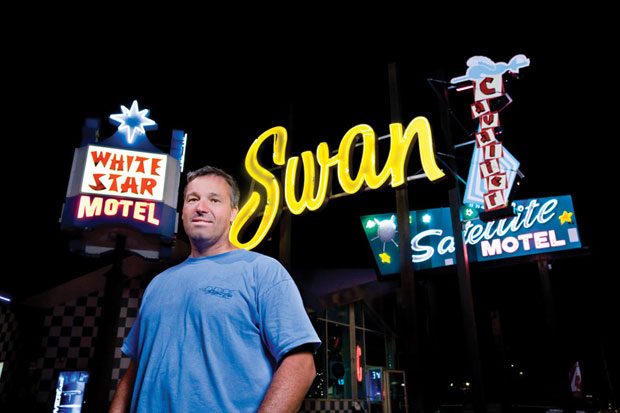
The glass arrives as 4-foot-long hollow tubes, each coated on the inside with one of dozens of different fluorescent-colored powders.
Inside the ABS Sign Company on Park Boulevard in Wildwood, Randy Hentges carefully heats the tubes over a natural-gas burner to 1,200 degrees. After about 30 seconds, the glass softens. Hentges quickly begins shaping the pieces, bending them by hand into palm trees, a cowgirl, a wave or a string of letters. (The heat doesn’t travel down the glass, so it can be held a few inches from the hot spot.) With each bend, Hentges checks the shape against his pattern, usually laid out on a fire-resistant sheet.
Hentges is a tube bender, a craftsman who painstakingly turns glass sticks into works of art that will jump right off a motel or restaurant sign.
The Swan, the Satellite, the Carousel, the Crusader, the Aztec, and more recently, the Starlux, Cool Scoops Ice Cream Parlor and the Coastal Broadcasting building—if there’s a flashy neon sign in Wildwood, chances are it was designed and built by ABS, the company founded in 1964 by Randy’s father, Robert Hentges.
Each piece of colored glass, Hentges says, has the potential to be two different colors once lit, depending on the type of gas—neon or argon—used to fill the tube. A glass tube coated in blue fluorescent powder, for example, produces a pink light when filled with neon, but emits a darker, steely blue light when filled with argon. More than 80 different color combinations are possible.
Hentges attaches glass casings with electrodes to both ends of the tube using a propane hand torch. For tubes to be filled with argon, he adds a drop of mercury to brighten the color.
A vacuum pump sucks the air out of the tube’s end. Next, Hentges fills the tube with gas, sealing it with a crossfire burner. The sign can now be hooked up to a transformer. Then, the glass glows with up to 15,000 volts—often emitting a distinctive humming sound.
Despite their fragile appearance, Hentges says the tubes can take a beating. “It pretty much lasts damn near forever,” says Hentges, 48. “If [a sign] doesn’t get broken, there’s not a lot of maintenance.”
Hentges appreciates seeing his signs light up the Wildwood landscape, but their presence doesn’t guarantee a bright outlook for his shop. The neon market isn’t what is used to be. “It’s like any other business…just trying to figure out how to keep the lights on and pay the guys,” Hentges says.
Lately, LEDs have become the lighting of choice for many businesses. Cost-prohibitive just a few short years ago, LEDs are now cheaper to make and operate than neon, with easier assembly, fewer parts and lower energy requirements. And a scarcity of parts for the old, original neon signs is making restoration increasingly difficult.
The trend has forced Hentges to adapt, creating signs that are a mix of neon and LED lighting. A recent sign he completed for the El Coronado Resort in Wildwood Crest has LED letters and a neon border.
“We used to get a lot of people wanting doo-wop this and doo-wop that,” Hentges says. “Not so much anymore.”
But don’t expect Hentges to give up being a tube bender. He loves what he does. And he contends that LED can’t do justice to the Wildwoods’ aesthetic vision.
“Palm trees?” Hentges scoffs. “You can’t do that with LEDs. It’s not the same. You can’t bend LEDs like that.”
And the neon keeps humming.

